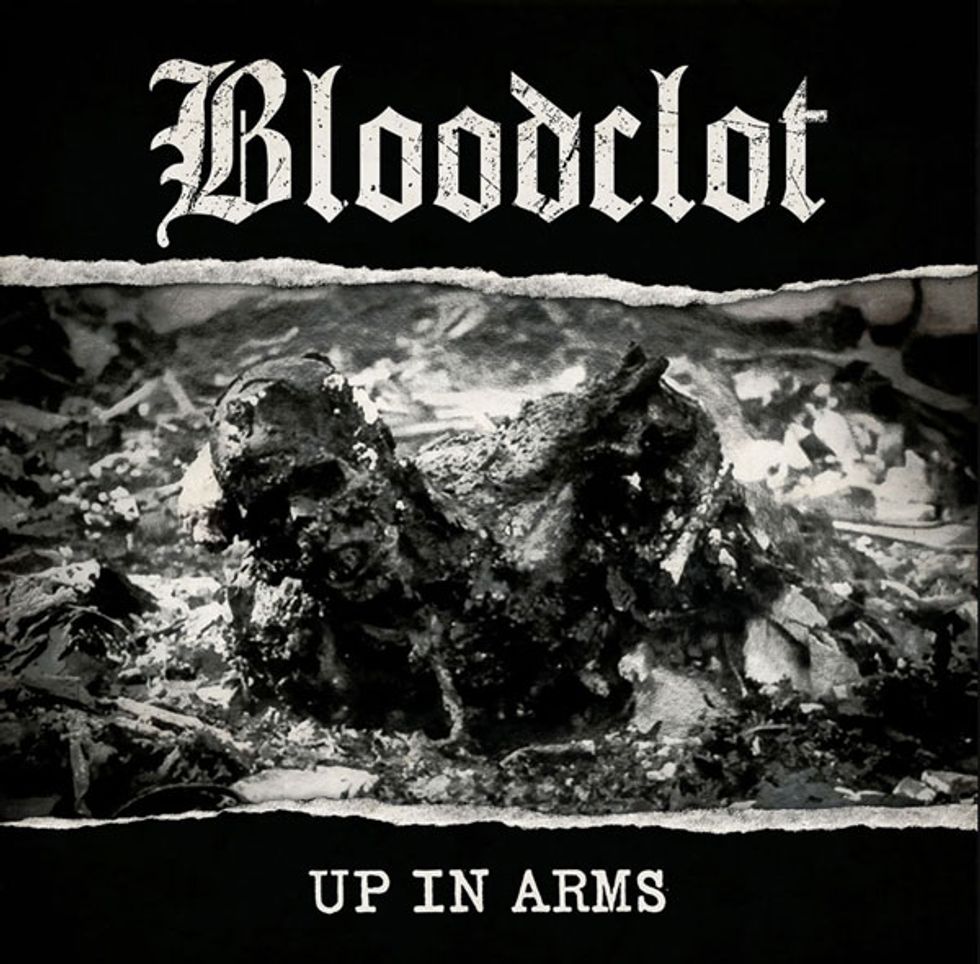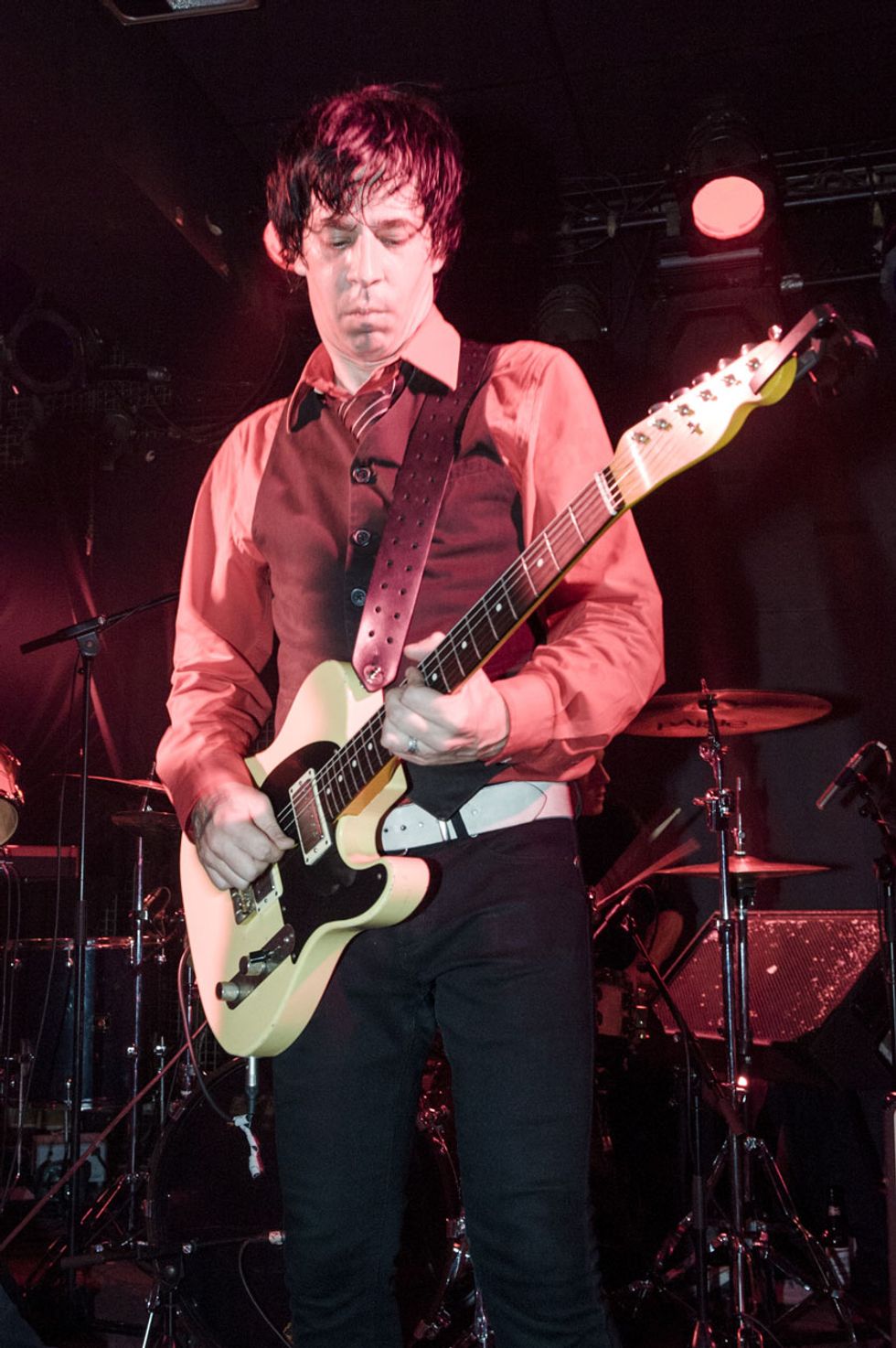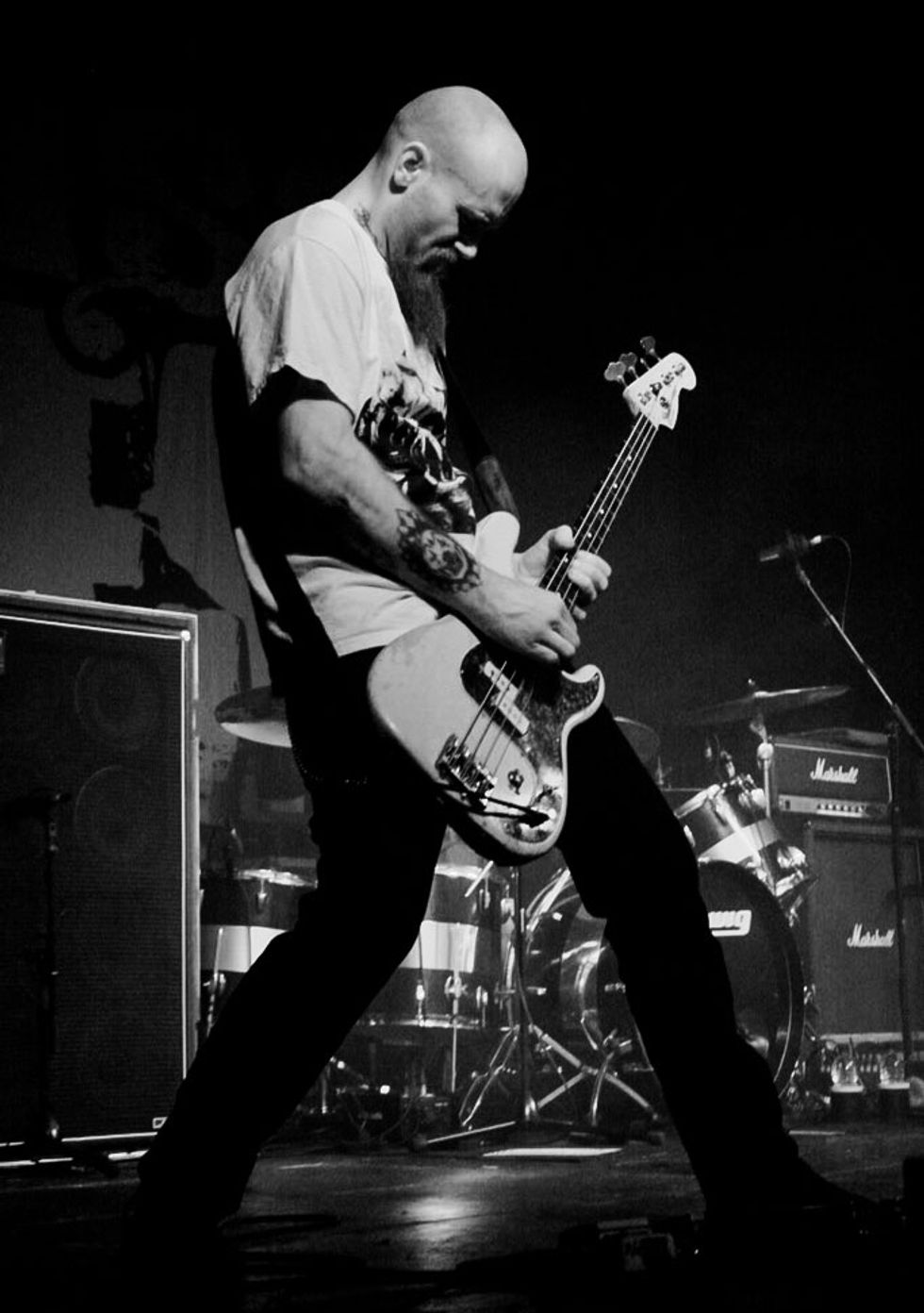American hardcore punk has traveled the world, evolved through myriad sonic and ideological trends, and returned to its origins many times since its inception in the early 1980s. The form has reached and influenced astonishing numbers of people since its days as a fringe movement, and while you may not always be privy to it, people from musical worlds as disparate as Moby and the Beastie Boys have deep roots in hardcore.
Despite the genre’s far reach and the scores of famous alumni, its club of true originators remains a small one. And the group of musicians that was there for the advent of the genre and still continues to create new music in its tradition is smaller still. With the new supergroup Bloodclot, a few of the style’s defining players and lifelong disciples seek to pump fresh hemoglobin into the body of hardcore the only way they know how: By returning to the roots they helped plant.
Fronted by John Joseph, original singer for the legendary Cro-Mags, Bloodclot’s violent pulse is provided by ex-Queens of the Stone Age rhythmic punishers Joey Castillo and Nick Oliveri (on drums and bass, respectively), with hardcore lifer and guitar journeyman Todd Youth (known from stints in Agnostic Front, Warzone, Murphy’s Law, Motörhead, and Danzig) handling 6-string duties. Bloodclot’s self-titled debut finds the band forging hardcore that is incendiary, urgent, and contains the kind of power and conviction that’s not only integral to this style of punk, but sorely lacking in 2017.
The union of these four serendipitously marks the completion of a circle dating back to the mid ’80s, when their paths first started crossing. Oliveri cut his teeth on thrash-inclined crossover hardcore, and appeared as an excited, long-haired teenager in the music video for the Cro-Mags anthem “We Gotta Know.” Castillo’s career as a drummer began with L.A. punks Wasted Youth, and it was during an East Coast tour with that group that he first met Bloodclot frontman Joseph. While New York hardcore legend Youth’s punk provenance requires little introduction, Bloodclot finds the guitarist returning to the genre (and the company of his former Danzig bandmate, Castillo) after recent years spent working alongside rockers like Ace Frehley and the late Wrecking Crew guitarist and country music icon Glen Campbell.
Premier Guitar sat down with Youth and Oliveri over slices of pizza at Scarr’s in New York’s Lower East Side—the neighborhood of Youth’s and Joseph’s hardcore education—to chat about writing and recording Up in Arms, Bloodclot’s absolute barnstormer of a debut. They also discussed the influences that go into a record like this hardcore manifesto after so many years in the game, the infallible glory of an old Les Paul through a loud Marshall, and literally stealing the bass tone from the first Bad Brains album—right down to the settings.
How do you say something new and relevant in the hardcore idiom in 2017?
Todd Youth: Well, with this record, the four guys involved all lived through the era that defined that sound and were all a real part of that scene: It’s in our DNA. I was actually there to see the Bad Brains at CBGB back in the day. John was a roadie for the Bad Brains. Nick saw the Cro-Mags for the first time when he was 14 and is actually in the video for “We Gotta Know,” and I’ve known Joey since 1984 when he first came to New York with Wasted Youth. So we were all there for the beginning of this sound. That history means the whole thing comes naturally, because we’re guys who helped to create it. John sang on [the Cro-Mags’ debut] The Age of Quarrel—as important a hardcore record as there is—so we felt really comfortable doing what we wanted to do without too much concern for the direction.

TIDBIT: After Up in Arms was recorded, all of Oliveri’s bass tracks were reamped through an old Peavey Mark IV to achieve a more authentic vintage crossover hardcore sound.
I pay attention to the new bands, and there are some good ones out there, but a lot of these kids are going back and looking at the shit we did 30 years ago and intellectualizing it. This is an authentic statement from the people that helped to invent the thing. And there are riffs on this album that come directly from my past. For example, on the song “Siva / Rudra” … the “Rudra” half is the very first riff I ever wrote, when I was 12 and playing bass in Agnostic Front. I brought that fast riff —as it appears on “Siva / Rudra”—to [Agnostic Front singer] Roger Miret, and he slowed it down and it became “With Time” on the Victim in Pain record.
Nick, you and Joey have done a lot in the punk world since your respective departures from Queens of the Stone Age. But this is the first hardcore record you and John have done in a long time, right Todd?
Youth: I haven’t done a true hardcore record since I was in Murphy’s Law in 1994.
Oliveri: Since I left Queens, I’ve been trying very much to only play on things I really like. I love the Bloodclot record and I listen to it all the time.
I think it’s safe to assume a lot of people that know you exclusively from your tenures in Queens of the Stone Age or Kyuss may be ignorant of your history as a hardcore musician and fan, Nick.
Oliveri: I’ve been a member of the Dwarves for 23 years now. The reason I left Kyuss was that it was already stoner-sludge stuff and the songs kept getting slower and longer, and I just wanted to play faster and shorter songs. I ended up joining the Dwarves at that point, which was perfect because I always wanted to play fast. That’s the music that moves me!
I remember when crossover hardcore happened, I truly loved it. It had the raw power that I couldn’t get really anywhere else. Bands like the Cro-Mags and Corrosion of Conformity, D.R.I.—that stuff came out when I was a kid, but I still think that period in the ’80s was the best period of music. Bands like the Bad Brains were such a benchmark.
Todd Youth, shown here ripping on a customized Tele with Jesse Malin’s St. Mark’s Social in 2010, says the secret to playing great hardcore 6-string is to learn to play its intense rhythms on acoustic guitar, “where you can’t hide behind
the power of an amp.” Photo by Jordi Vidal
How did Bloodclot come to fruition?
Youth: The current iteration of the Cro-Mags had a gig, and A.J. Novello’s [of Leeway] mom had just passed away and he couldn’t make the gig. John called me up on a Wednesday and asked if I could do the gig on that Friday—no rehearsal, no soundcheck. I landed at 8:10 and I was onstage by 8:45. The gig went well and John and I got to talking and we got into the idea of doing new shit together, so I started writing songs and demoing things and sending them to him.
John put lyrics together in NYC and he came out to L.A. for a few days on the way to Hawaii, where he was going to compete in an Iron Man competition. He ended up tearing a ligament in his leg and couldn’t do his race, but he was already in L.A, so we had the time, and we had the songs, and I called up a friend at NRG Studios and they did me a favor on short notice and we went in and cut three songs and those songs got us a deal with Metal Blade.
Nick, how did you come into the fold?
Oliveri: I was playing in a hardcore band called BL’AST, with Joey [Castillo], and Joey mentioned something about playing in a new band—just asked if I’d be into it maybe, but it wasn’t something real yet. It was just an idea being thrown around, but eventually we talked with Todd at a BL’AST show at the Roxy [in Los Angeles] with Sick of It All, and Todd sent me some songs after that to check out and I was blown away! The demos are absolutely insane. I immediately thought to myself: “This is what I’ve been waiting to hear from John Joseph for years!” For me, I’m a huge, big-time Cro-Mags fan, and Age of Quarrel is the record for me. It’s the one. The Bloodclot record is similar in that it’s authentic, and I felt it and the conviction behind it when I first heard it. I was just lucky enough to get in on it!
Youth: When we went into this, I asked myself what I, as a Cro-Mags fan, would’ve liked to have heard from the second Cro-Mags record had things not changed with the lineup. That thinking is a big part of the heart of the Bloodclot record.
Todd, as a player that’s built a career writing mean rhythm parts, is there a key to this particular style of rhythm guitar?
Youth: This is going to sound nuts, but the key to it is learning to play that style on an acoustic guitar, where you can’t hide behind the power of an amp. Another thing is avoiding the thrash guitar thing, where dudes do a lot of alternate picking or do straight-down strokes, but don’t necessarily give a part any movement. That thing has its place, but for hardcore—and the Bad Brains again pop up as a huge point of reference here—I’ve always been drawn to the thing they had where the rhythm parts had a bounce to ’em. Despite how simple a fast guitar part may sound, when Dr. Know plays it, it has accent points that give it that vicious bounce, and it’s that subtle shit that really makes a difference.
Joey and I talk about this a lot, but the truth is, hardcore guitar playing is what it is, but what the bass and drums do are what gives it its power. The bass can never be quite loud enough for me. As a rhythm player, the fact that I spent my formative years playing bass in Agnostic Front really shaped the way I do things, and it taught me the importance of locking with a drummer in a hardcore band. The best hardcore records have the bass lock in with the bass drum as a single entity and, to my ears, that’s where that violence comes from. It just makes you want to fuck shit up! Nick and Joey have so much experience together that they lock in unlike anyone else.
 Guitars
Guitars1971 Gibson Les Paul Standard
2017 ESP LTD EC-1000
Amps
1970s 100-watt Marshall JMP
1980s JCM800 with L.A. Sound Design mods
50-watt EVH 5150 III
Effects
Ibanez Tube Screamer
Dunlop Cry Baby wah
Strings and Picks
Dean Markley strings (.010–.046)
Dunlop Herco Flex 75 picks
Nick, can you talk a bit about your philosophy as a bassist?
Oliveri: I always want to attack the parts and really command the rhythm of the song. I was a guitarist first, so I developed my picking style early, and I prefer the attack a pick gives you in general. Lemmy from Motörhead was like a God to me, and I really love his style of bass guitar. Obviously the Cro-Mags are there, too, so the sound from Age of Quarrel was hugely influential. There’s a lot to be said for not overplaying and still having a fast, controlled right hand.
The bass guitar is such an integral part of the record’s sound. What’d you guys use to track the bass on the album?
Youth: The secret to the bass tone is actually a very funny story. We started recording the bass and we brought in a vintage Marshall Super Bass, which sounded great. The first thing I did when I played in Motörhead was go up to Lemmy’s amp onstage and check his settings: Everything was dimed, but the bass was at zero! So we bring in the Super Bass and use the Lemmy settings, and we bring in a vintage SVT and that, too, sounded fantastic. Fast forward to the mixing process and I say to myself, “Fuck man, I’m not feeling the bass. I don’t like the bass tone.” It didn’t have that thing I wanted where it rides on top of everything and punches you.
So I start geeking out really hard to solve it and I hit up Darryl Jenifer from the Bad Brains and I ask him what he used on the ROIR cassette (their 1982 debut, Bad Brains, on Reachout International Records), and he goes, “Aw man, I don’t know. We had so much stuff back then, I really don’t know.” So I start digging and I find a picture of the Brains rehearsing at 171 Avenue A, which is where they lived, and also where they recorded that cassette. And he was using an old Peavey Mark IV. Then I came across a photo of Brian Baker from Minor Threat using the same amp, and I love Minor Threat’s bass sound—especially on [1983’s] “Betray.” Then, I saw a photo of Harley Flanagan playing at the first Cro-Mags gig, taken around the time they were recording the demo, which has a tone that I think destroys the bass sound on Age of Quarrel. So all of these guys were using Peavey Mark IVs, and I call Darryl back and ask him if he remembers the settings he used to use with the Mark IV, and he goes “Oh yeah, man! I remember. I had the Mark IV because I couldn’t afford an Ampeg at the time, so that was my shit! Hell yeah, I remember my settings. That was my amp forever!” So now I have Darryl’s settings and I mention it to Nick and send him a picture of the amp and he goes, “Oh shit, I have three of those!”
We ended up reamping all of the bass on the album through a Mark IV, and as we’re reamping the bass—which everyone can hear because we did it so loud—Jay Baumgardner [producer of Up in Arms and owner of NRG Studios] walks in all proud and goes, “Is that my SVT?” And I go, “Nope, it’s a $150 Peavey!” And he yells at the engineer, “Find me one of those now!” It was hysterical, but that’s the key to the bass tone on this album, again, following the theme of doing things in line with how we used to, right down to the settings. No pedals or anything.
Despite his allegiance to Bloodclot, Nick Oliveri has multiple irons in the fire. Here, he’s onstage with Kyuss Lives!, which features Oliveri and two other original members of the influential stoner-rock band. Photo by Emma Farrer
Nick, what bass were you using to track?
Oliveri: It’s a bass my pal made for me. He built it out of Allparts stuff. He goes, “Bring me your favorite bass and I’ll make you something like it, but better.” I brought him the one I use all the time, which is a P bass with a Jazz Bass pickup added at the bridge, and he goes “Dude, how do you play that thing with the action so high?” And it’s because I set them up myself, but I learned how to deal with it because I pick fast and I don’t want the strings bouncing off the neck too much. Pat came back with this awesome P-and-J Bass, loaded with Seymour Duncan Quarter Pounder pickups and a Badass II bridge. It’s got much lower action than my old bass, but it doesn’t buzz or bounce too hard off the fretboard. I used that for the album and I’m loving that thing.
Todd, what amps did you use to get those giant guitar sounds?
Youth: A 100-watt master volume JMP, which is the classic amp for hardcore, and a JCM800 that was modded by Martin Golub at L.A. Sound Design to have just a little bit more gain. For some spots, I was using one of the new 50-watt EVH 5150 IIIs, and I love those amps! I can get them to sound like a JMP at lower volumes and they’re more reliable than some of the old Marshalls.
What about guitars?
Youth: I cut most of it with a 1971 Les Paul Standard that was just smoking! DiMarzio Super Distortions. No funny business: just a Les Paul into a Marshall!
The instruments are so rhythmically tight that it all works as a single unit. Did you track to a click?
Youth: No. Joey’s a human click! And that’s another thing with this kind of music: A click sucks all the soul out of it. It’s got to pull and push, and in certain spots we sit far back on it, and other spots we push it. Joe’s great and can play all around a click, but working to a click really saps the human quality and that violent bounce from it.
style of bass guitar.” —Nick Oliveri
Todd, you’ve had an extremely varied career. Coming back to making a traditional hardcore record after that kind of musical journey, what do you bring to the table differently as a player than when you were a kid and cut those seminal albums?
Youth: It’s painful when I listen to any Warzone shit, because it was done right when I was learning how to play lead guitar and it’s just rough, but the reality is that my childhood—and my progress learning and coming up as a musician—is on YouTube. Every year of my life as a musician is on there, so I can see it was at about age 18 when I sort of went “ah!” and my guitar playing started clicking. At the record-release party, John summed it up best when he said, “Between us, there’s 140 years of playing experience in this band.” And that’s fuckin’ heavy, man! So I think it’s just the kind of thing that experience teaches: confidence and efficiency. I don’t second guess myself these days.
Nick, what was it like for you making this record after having been involved with so many different projects and styles over the years?
Oliveri: A lot of the bands I’ve played in and I’m known for being involved with aren’t doing things that I’m into anymore, and I feel like this is where I should really be musically. I’m very proud of the music I’ve made with every band I’ve been in over the years, but this project really satisfies what I’m about as a player. It’s what I’ve always wanted to do. I was just never surrounded with the right people to do it. My whole childhood was spent listening to crossover hardcore and thrash and there’s a lot of punk attitude in music I’ve made in the past, but this is exactly what I’ve been waiting to do.
Todd, the guitar solos on the record are all burners. Were they premeditated or were you just letting it rip?
Youth: It was all done on the fly, solo-wise. I wanted to get more away from what I normally would do, which is that Ace Frehley rock ’n’ roll thing, and get more of a chaotic feel to things.

Basses
Custom Pat Rowan P+J Bass
Vintage Ampeg Dan Armstrong Lucite
Amps
Peavey Mark IV
Effects
None
Strings and Picks
Dean Markley strings (.045–.105)
Steve Clayton 1 mm picks
My favorite solo on the record is in “Siva / Rudra.” I dig the chewy wah tone on it a lot. Can you tell me what you used on that one?
Youth: That’s that Les Paul into a Tube Screamer, into a Dunlop wah, and then into a Marshall. That solo there is my actual ode to Dr. Know’s style of lead guitar.
What is it about Doc Know’s playing that hooked you so deeply?
Youth: I can’t think of a player who takes leads in the past 30 years that comes close to Doc as far as originality. His note choices, but more importantly, his fearlessness! He’s truly fearless, and if he hits a wrong note, he makes it sound right somehow. His feel is just so next level, and we have the same story in a lot of ways. He started as a bass player, like me. I think all guitarists should spend a year or two as a bass player in a band to really understand the conversation that’s going on between a bassist and a drummer. “Fast” Eddie Clarke from Motörhead was also a huge influence on my style, and I think it comes out the most in my playing these days.
Who would you cite as key influences on your development as a player, Nick?
Oliveri: I think Chuck Dukowski from Black Flag is one of the best. I think Lemmy was probably the best. John will probably get mad at me for saying so, but I think Harley Flanagan is a great bass player and his style obviously influenced me. But Lemmy was the big one for me.
As a 14-year-old kid I went to see Motörhead play and the Cro-Mags opened. When they played, between the crazy pits and everything that was going on and the energy onstage, it just seemed like the band was levitating. I can still see it clearly now, and it was so magical. It was absolutely surreal. That was a life-changing thing for me. At that moment, I knew I wanted to play music for the rest of my life. It was such a pivotal thing.
I’ve always found the early East Coast hardcore scene to contain some truly gifted, athletic, outside-thinking guitarists—especially compared to some of their West Coast contemporaries. What’s your take on why that is, Todd?
Youth: There was a club [in New York] called A7, and it’s known as Niagara these days, but they had no liquor license and it was an illegal bar and cops would come and raid it all the time. Bands wouldn’t start until 2 in the morning, and Tuesday nights were reggae night and the neighborhood dreads would be in there jamming. A drummer or a bass player or a guitarist wouldn’t show up, and I’d be in there and fill in. So I learned how to play all of these different kinds of music in that bar. That, and being around dudes like the Bad Brains.
I always tried to be a musician first. Like when I first heard Mahavishnu Orchestra and caught “Inner Mounting Flame,” and it clicked that that was where the Bad Brains got a lot of their intros and ideas from. I called Doc and called him out on it, and he laughed, but it has to do with New York being such a melting pot and being surrounded by so much different shit. I think being a New Yorker at that time, and in that world—where we didn’t know where our next meal was coming from unless the Hare Krishnas were serving food in the park—we were playing for our lives. I try to still do that. I think we’re all coming from a place like that in this band.
Nick Oliveri punishes his custom bass while Todd Youth blasts his Les Paul through a Marshall at Saint Vitus in Brooklyn during a set packed with songs from Bloodclot’s debut, Up in Arms.
















![Rig Rundown: Russian Circles’ Mike Sullivan [2025]](https://www.premierguitar.com/media-library/youtube.jpg?id=62303631&width=1245&height=700&quality=70&coordinates=0%2C0%2C0%2C0)
















![Rig Rundown: AFI [2025]](https://www.premierguitar.com/media-library/youtube.jpg?id=62064741&width=1245&height=700&quality=70&coordinates=0%2C0%2C0%2C0)




















 Zach loves his Sovtek Mig 60 head, which he plays through a cab he built himself at a pipe-organ shop in Denver. Every glue joint is lined with thin leather for maximum air tightness, and it’s stocked with Celestion G12M Greenback speakers.
Zach loves his Sovtek Mig 60 head, which he plays through a cab he built himself at a pipe-organ shop in Denver. Every glue joint is lined with thin leather for maximum air tightness, and it’s stocked with Celestion G12M Greenback speakers.






